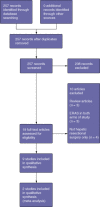Enhanced recovery following liver surgery: a systematic review and meta-analysis
- PMID: 24661306
- PMCID: PMC4113251
- DOI: 10.1111/hpb.12245
Enhanced recovery following liver surgery: a systematic review and meta-analysis
Abstract
Background: Enhanced recovery after surgery (ERAS) programmes aim to improve postoperative outcomes. They are being utilized increasingly in hepatic surgery. This review aims to evaluate the impact of ERAS programmes on outcomes following liver surgery.
Methods: EMBASE, MEDLINE, PubMed and the Cochrane Database were searched for trials comparing outcomes in patients undergoing liver surgery utilizing ERAS principles with those in patients receiving conventional care. The primary outcome was occurrence of postoperative complications within 30 days. Secondary outcomes included length of stay (LoS), functional recovery and adherence to ERAS protocols.
Results: Nine articles were included in the review, of which two were randomized controlled trials (RCTs). Overall complication rates were 25.0% (range: 11.5-46.4%) in ERAS patients, and 31.0% (range: 11.8-46.2%) in conventional care patients. Significantly reduced overall complication rates following ERAS care were demonstrated by a meta-analysis of the data reported in the two RCTs (odds ratio: 0.49, 95% confidence interval 0.28-0.84; P = 0.01) The median LoS reported by the studies was 5.0 days (range: 2.5-7.0 days) in ERAS patients, and 7.5 days (range: 3.0-11.0 days) in non-ERAS patients. Recovery milestones, when reported, were improved following ERAS care.
Conclusions: The adoption of ERAS protocols improves morbidity and LoS following liver surgery. Future ERAS programmes should accommodate the unique requirements of liver surgery in order to optimize postoperative outcomes.
© 2014 International Hepato-Pancreato-Biliary Association.
Figures
References
-
- Kehlet H, Wilmore D. Evidence-based surgical care and the evolution of fast-track surgery. Ann Surg. 2008;248:189–198. - PubMed
-
- Scott N, McDonald D, Campbell J, Smith R, Carey A, Johnston I, et al. The use of enhanced recovery after surgery (ERAS) principles in Scottish orthopaedic units – an implementation and follow-up at 1 year, 2010–2011: a report from the Muculoskeletal Audit, Scotland. Arch Orthop Trauma Surg. 2013;133:117–124. - PubMed
-
- Lv D, Wang X, Shi G. Perioperative enhanced recovery programmes for gynaecological cancer patients. Cochrane Database Syst Rev. 2010;(6) CD008239. - PubMed
-
- Arsalani-Zadaeh R, ElFadl D, Yassin N, MacFie J. Evidence-based review of enhancing postoperative recovery after breast surgery. Br J Surg. 2011;98:181–196. - PubMed
-
- Kehlet H. Multimodal approach to control postoperative pathophysiology and rehabilitation. Br J Anaesth. 1997;78:606–617. - PubMed
Publication types
MeSH terms
LinkOut - more resources
Full Text Sources
Other Literature Sources
Medical


